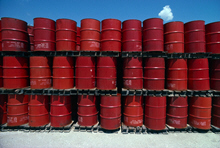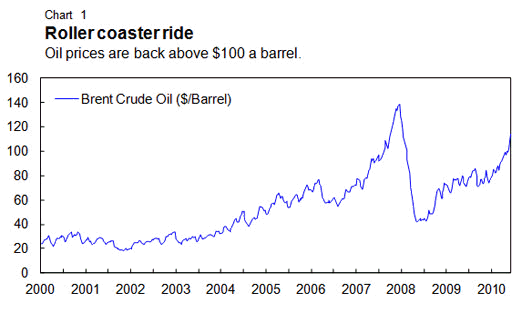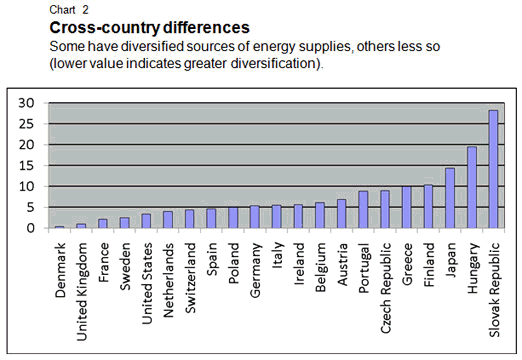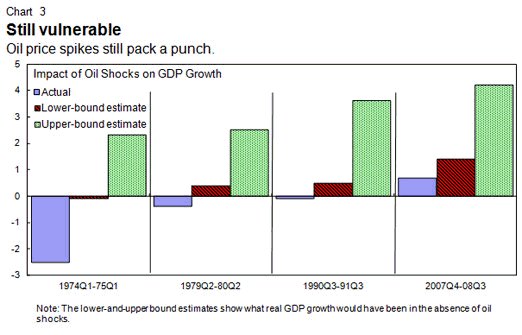
Typical street scene in Santa Ana, El Salvador. (Photo: iStock)
IMF Survey: Rising Oil Prices Highlight Need for Diversification
March 23, 2011
- Countries have built up some resilience to oil spikes but remain vulnerable
- Diversification in sources of oil, natural gas supplies provides cushion
- Policy response to oil spikes should be multilateral, multipronged
World oil prices are back above $100 a barrel, more than double what they were two years ago, but increased diversification of energy supplies has given many economies greater resilience to price fluctuations.

More oil sector investment is crucial for greater oil price stability, but recent oil price surges prompted only modest capacity increases (photo: Newscom)
ENERGY ANALYSIS
Nevertheless, while countries have built up some ability to withstand oil price shocks and some are less sensitive, they remain vulnerable to severe supply disruptions or to the uncertainty induced by extreme oil price volatility, highlighting the need for a continuing multipronged policy response that has three main elements.
• Bolstering oil supplies and investment;
• Increasing the responsiveness of oil demand to price signals; and
• Nudging along a transition from oil to other fuels and renewable sources of energy.
Need to boost investment
On the supply side, increased investment in the oil sector is crucial in bringing greater stability to oil prices. Surges in oil prices in recent years have resulted in only very modest increases in capacity. The sluggish response appears due to rising exploration and development costs and the lack of predictable regulatory and tax regimes that would provide adequate returns for expanding supply and infrastructure. Political turmoil of course makes it all the more difficult to sustain increased investment.
Strengthening the demand response to oil price changes is critical as well. In 2008, IMF First Deputy Managing Director John Lipsky noted that “relatively low gasoline taxes in the United States, low domestic prices in China, and heavily subsidized and controlled prices in many oil-exporting and other developing countries discourage” the demand-side response that is needed. Policies to increase energy efficiency, for instance through better fuel-efficiency standards, can strengthen the demand response.
Increasing diversification
The recent volatility follows a roller coaster ride in which oil prices rose from $35 in 2004 to over $140 in July 2008, only to plunge back to $35 by the end of that year (see Chart 1).

Oil price spikes in the mid-1970s and early 1980s are widely believed to have contributed to the recessions that followed in the United States and many other countries. Since that time oil importers have taken a number of steps to increase their resilience to such shocks.
One key step is diversification. As documented in recent IMF research, many countries have increased the number of sources from which they import oil, making them less vulnerable to disruptions from any one source. The United States, for instance, buys crude oil and gasoline from more than 40 countries and jet fuel from more than 25 countries. Over the past two decades, Saudi Arabia, Iran, the United Arab Emirates, Indonesia, and Mexico have seen a decline in their share of world net exports of oil, with a corresponding increase in the shares of Russia and Angola.
Countries have also increased their use of natural gas and are importing from many more sources as well. Norway has continued to grow in importance as an exporter of natural gas, and several new producers have emerged—Qatar, Turkmenistan, Nigeria, Egypt, and Australia.
As a result of all these changes, oil-importing countries are much more diversified in their sources of supplies than they were two decades ago. For oil-importing countries of the Organization for Economic Cooperation and Development as a whole, diversification in sources of oil supplies increased significantly over the 1990s and has remained roughly constant since then. Diversification in sources of natural gas has increased steadily over the past two decades.
Differences between countries
While the general trend is toward increasing diversification, there are significant differences across countries in their exposures to particular oil suppliers (see Chart 2). For instance, IMF research finds the United States and the United Kingdom have much more diversification in their sources of energy supplies than countries in continental Europe. Within continental Europe, larger energy importers such as France and Germany are much more diversified than smaller importers such as Finland and the Slovak Republic.

And oil still packs a punch
Economies remain vulnerable to oil price shocks, according to James Hamilton of the University of California, San Diego, an expert on oil-economy interactions, although today this is much smaller than the impact on economies during previous oil price spikes. Using two alternative models of energy-economy interactions, Hamilton finds that in the absence of the oil price increases in 2007–08, real incomes in the United States would have risen by 1½ percent to 3 percent, much higher than the actual growth of ¾ percent (see Chart 3).

Hence oil can still spoil the economic outlook, much as it did in 1974–75, 1979–80 and 1990–91, the three other periods of oil spikes illustrated in the chart.
But economies less sensitive
But, along with diversification in sources of energy supplies, IMF Chief Economist Olivier Blanchard has noted two other changes of importance.
• Inflation: Central banks have become much better at establishing an anchor for inflation expectations. Hence the public in many countries is much less fearful that oil prices will have inflationary consequences than was the case in the past. This allows the central bank to be much more supportive of promoting recovery in the economy rather than having to raise interest rates to dampen inflationary expectations.
• Wages: Increased oil prices no longer feed a wage-price spiral, as they did in the 1970s and 1980s when workers were able to bargain for increased compensation.
These structural changes have reduced the sensitivity of the economy to oil spikes. In joint work with noted economist Jordi Gali, Blanchard estimates that, for the United States, the effects of an oil spike on output and inflation are only a third as large today as they were two decades ago.


